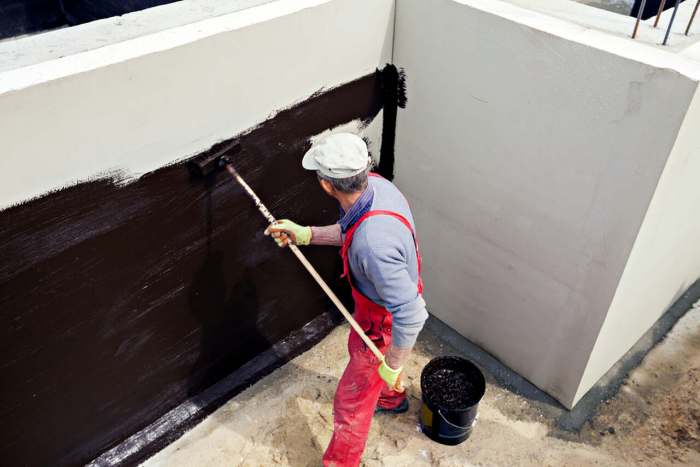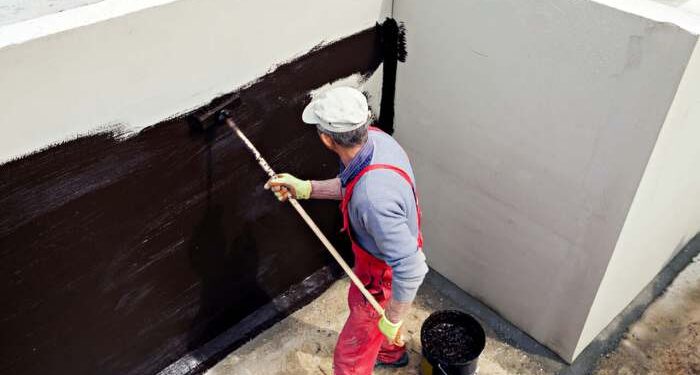Exploring the realm of exterior waterproofing solutions for older buildings unveils a world of essential knowledge and practical insights. From understanding the significance of waterproofing to delving into the various types of solutions available, this topic promises to be both informative and engaging.
As we navigate through the intricacies of preserving historical structures and tackling common issues faced by aging buildings, readers are bound to gain a newfound appreciation for the importance of exterior waterproofing.
Overview of Exterior Waterproofing Solutions for Older Buildings
Exterior waterproofing is crucial for older buildings to protect them from water damage, mold growth, and structural deterioration. Without proper waterproofing, water can seep into the foundation and walls, leading to costly repairs and health hazards.Common issues faced by older buildings that require waterproofing include cracks in the foundation, deteriorated mortar joints, porous bricks or stones, and inadequate drainage systems.
These issues can result in water infiltration, which can weaken the structure over time.Investing in exterior waterproofing solutions offers numerous benefits, such as extending the lifespan of the building, preventing water damage, improving indoor air quality, and increasing property value.
By addressing these issues proactively, property owners can avoid costly repairs and ensure the longevity of their building.
Types of Exterior Waterproofing Solutions
Exterior waterproofing solutions for older buildings come in various forms, each with its own advantages and suitability depending on the building's structure and location. Let's explore the different types of exterior waterproofing solutions available and compare and contrast their methods.
Sealing
Sealing is a common method used to waterproof exterior walls. This involves applying a waterproof sealant directly onto the exterior surface to prevent moisture penetration. Sealing is effective for small cracks and gaps but may not be suitable for larger areas or areas with significant structural issues.
Membranes
Membranes are another popular waterproofing solution that involves installing a waterproof membrane over the exterior walls. These membranes act as a barrier against water infiltration and are particularly effective for areas prone to heavy rainfall or high levels of moisture.
Membranes can be made of various materials such as bituminous, rubberized asphalt, or polyethylene.
Coatings
Coatings are applied directly onto the exterior walls to provide a protective layer against water damage. These coatings can be elastomeric, acrylic, or cementitious, and they help to seal the surface and prevent water intrusion. Coatings are versatile and can be used on various types of surfaces, making them a popular choice for waterproofing older buildings.
Drainage Systems
Drainage systems are essential for managing water runoff and preventing water from pooling around the foundation of older buildings. These systems can include French drains, downspouts, and gutters to redirect water away from the building. Proper drainage is crucial for maintaining the structural integrity of the building and preventing water damage.Overall, the choice of exterior waterproofing solution will depend on factors such as the building's condition, location, and budget.
It is essential to consult with a professional to determine the most suitable waterproofing method for your older building to ensure long-lasting protection against water damage.
Factors to Consider Before Applying Exterior Waterproofing

Before embarking on exterior waterproofing for older buildings, there are several key factors that need to be taken into consideration to ensure the effectiveness and longevity of the waterproofing solution.
Climate
Climate plays a significant role in determining the type of exterior waterproofing solution that should be applied to a building. Areas with high levels of precipitation or extreme weather conditions may require more robust waterproofing methods to prevent water infiltration.
Building Materials
The materials used in the construction of the building can also influence the choice of waterproofing solution. Different materials have varying levels of susceptibility to water damage, and certain waterproofing methods may be more compatible with specific building materials.
Existing Damage
Prior to applying exterior waterproofing, it is crucial to conduct a thorough inspection of the building to assess any existing damage. Identifying areas of weakness or deterioration will help in determining the most appropriate waterproofing solution to address these specific issues.
Historical Preservation Requirements
For older buildings that are of historical significance, there may be strict preservation requirements in place that limit the types of exterior waterproofing solutions that can be used. It is important to consider these restrictions and work within the guidelines to ensure the building's historical integrity is maintained.
Application Techniques for Exterior Waterproofing
Exterior waterproofing solutions for older buildings require a systematic approach to ensure effectiveness and long-lasting results. Here, we detail the step-by-step process of applying exterior waterproofing solutions, provide tips on surface preparation, material selection, and quality control during application, and discuss best practices for ensuring durability.
Surface Preparation
- Inspect the exterior walls for any cracks, gaps, or damage that could compromise the waterproofing.
- Clean the surface thoroughly to remove dirt, dust, and debris that could prevent proper adhesion of the waterproofing material.
- Repair any existing damage such as cracks or holes using appropriate sealants or patching compounds.
Material Selection
- Choose high-quality waterproofing materials that are specifically designed for exterior applications and compatible with the building material.
- Consider factors such as climate, exposure to moisture, and the age of the building when selecting the waterproofing material.
- Consult with a professional to determine the most suitable waterproofing product for the specific needs of the building.
Quality Control
- Follow the manufacturer's instructions carefully when applying the waterproofing material to ensure proper coverage and adhesion.
- Inspect the application periodically to detect any defects, bubbles, or inconsistencies in the waterproofing layer.
- Perform a water test after the waterproofing material has cured to verify its effectiveness in preventing water infiltration.
Last Word
In conclusion, the journey through exterior waterproofing solutions for older buildings serves as a reminder of the critical role this process plays in maintaining the integrity and longevity of architectural treasures. By investing in the right solutions and considering key factors, property owners can safeguard their buildings for years to come.
Answers to Common Questions
Can exterior waterproofing prevent mold growth in older buildings?
Yes, proper exterior waterproofing can help prevent moisture intrusion and subsequently reduce the risk of mold growth in older buildings.
Is it necessary to consult a professional before applying exterior waterproofing solutions?
It is highly recommended to seek professional guidance to assess the specific needs of your building and determine the most suitable waterproofing approach.
How long does exterior waterproofing typically last on older buildings?
The longevity of exterior waterproofing can vary depending on factors like maintenance, climate, and the quality of the initial application, but it can last for several years when done correctly.




